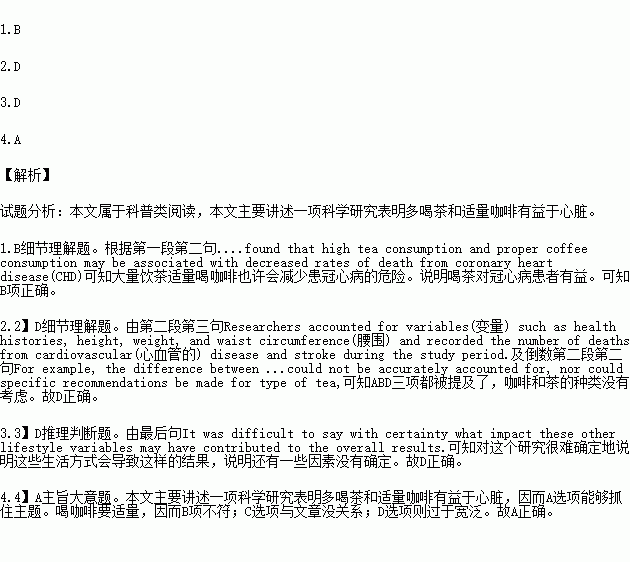题目内容
If drinking coffee or tea has become part of your daily routine, you might wonder what it's doing to your long-term heart health. New research from Arteriosclerosis, Thrombosis, and Vascular Biology, a journal (期刊)of the American Heart Association, found that high tea consumption and proper coffee consumption may be associated with decreased rates of death from coronary heart disease ( CHD)(冠心病).
The study followed more than 37,000 tea and coffee drinkers over 13 years. Participants completed food recalls to document their typical intake of tea and coffee, and were divided into groups that ranged from light to heavy consumption. Researchers accounted for variables(变量)such as health histories, height, weight, and waist circumference (腰围)and recorded the number of deaths from cardiovascular (心血管的)disease and stroke during the study period.
Overall results showed that consuming more than six cups of tea per day was associated with a 36% lower risk of death from heart disease compared to consuming less than one cup of tea per day. There appeared to be no such protective effect of tea-drinking at any amount for risk of death from stroke. Among coffee drinkers, more proper consumption levels (2-3 cups per day) were associated with the greatest risk reduction for death from heart disease (21% ) compared to drinking less than one cup of coffee per day.
Researchers acknowledged certain inconclusive variables within their findings. For example, the difference between decaffeinated(去咖啡因的)and regular coffee could not be accurately accounted for, nor could specific recommendations be made for type of tea, though due to its popularity in the Netherlands where the study took place, researchers assumed most tea consumption to be black tea.
Furthermore, researchers found that tea and coffee drinkers had opposite lifestyles, with tea drinkers tending to engage in healthy lifestyle habits and coffee drinkers being more likely to eat less healthy and smoke. It was difficult to say with certainty what impact these other lifestyle variables may have contributed to the overall results.
1.What's the conclusion of the study?
A. People should drink tea and coffee as much as possible.
B. Drinking more tea may benefit people with CHD.
C. High tea consumption may reduce the rate of stroke.
D. Coffee consumption has nothing to do with heart disease.
2.Which of the following variables haven’t been considered?
A. Health histories. B. Height and weight.
C. Waist circumference. D. The type of tea and coffee.
3.What can be inferred from the last paragraph?
A. All people in the Netherlands like black tea.
B. Tea and coffee drinkers had a similar life style,
C. Other variables have no effect on the results.
D. There are still something uncertain about the study.
4.Which of the following might be the best title?
A. Why our heart loves coffee and tea.
B. Drink more tea and coffee.
C. Heart disease will be reduced.
D. An amazing findings about heart diseases.

